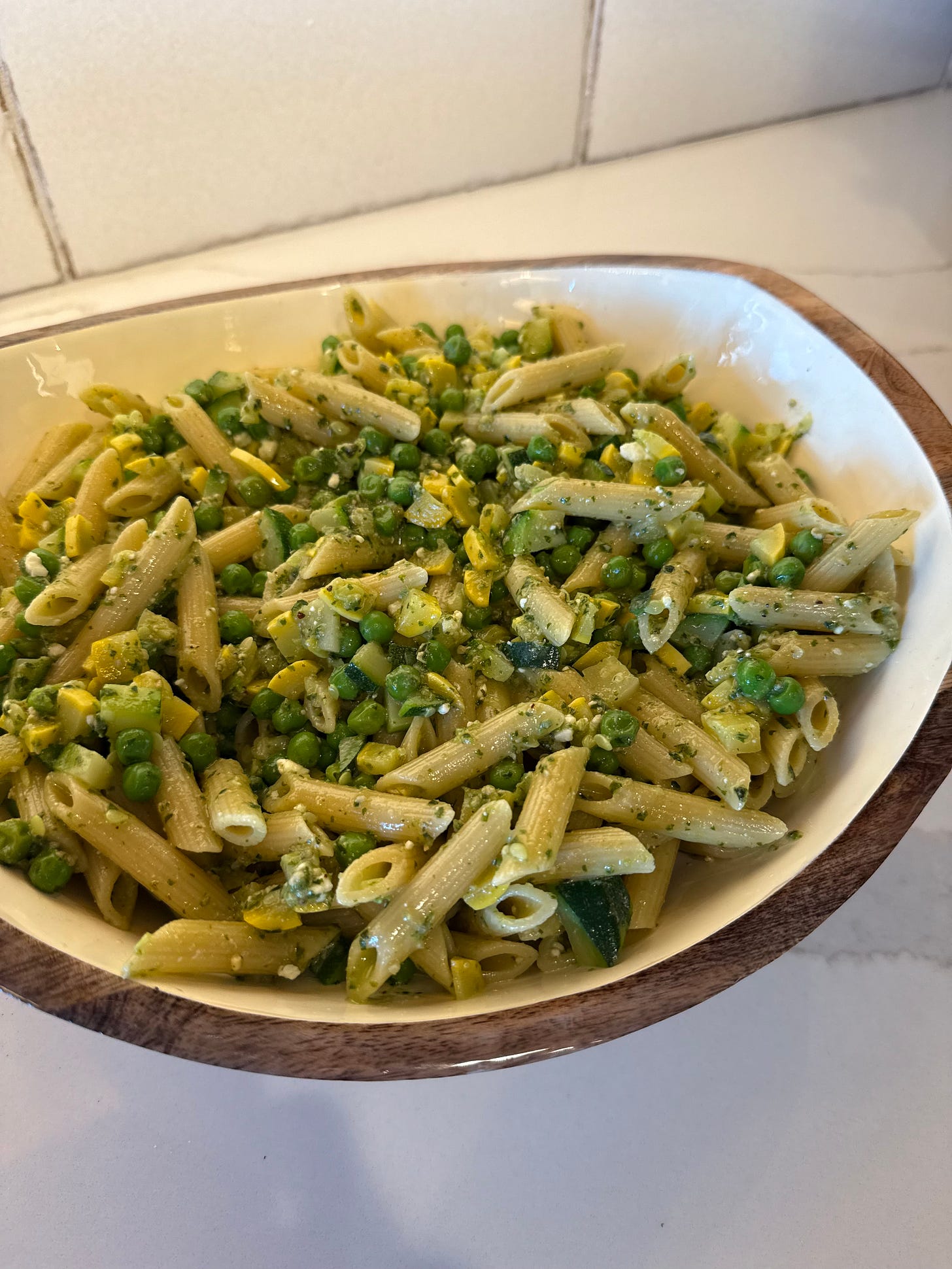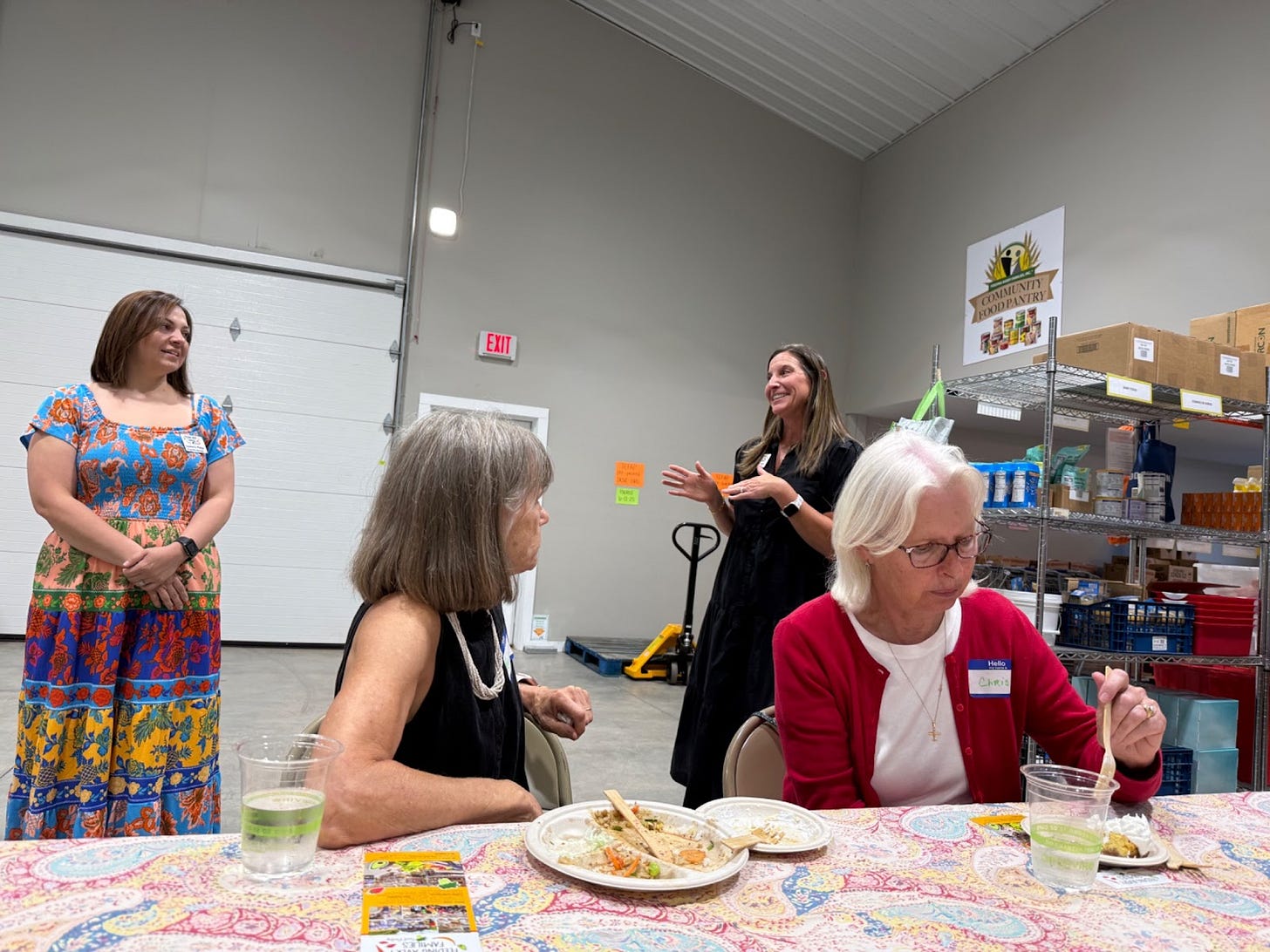What most people get wrong about community
What I learned about community from a potluck in a warehouse
Before leading a recent quarterly strategy workshop inside The Hive, I made a quiet promise to myself: take the morning off and go to yoga.
I’d been putting it on the back burner all summer, but one of our members, Christina Hubbard, has been gently nudging me to carve out time for myself. That day, I did.
As class was getting ready to start, the instructor made an offhand comment: “The green bowl is still out on the counter.”
Curious me couldn’t leave it at that. I asked what it was for.
She explained it was a donation bowl for Feeding Avery Families, and that night there happened to be a community potluck hosted by a grassroots group called GAPS—Giving At Potlucks.
I was immediately pulled in.
You see, the very reason I started my business was to be able to contribute financially to causes centered on nutritional equity. Our family walked a long road navigating our son’s complex medical condition. We traveled for years to find specialized care, help him gain weight, and simply survive.
We were lucky. We had access, advocates, support systems. But not everyone does. And back then, I didn’t have the time or means to give beyond what my son needed. So I made a quiet promise: someday, I will.
I’d been giving behind the scenes to support Feeding Avery Matters since I first learned about their mission.
I didn’t know what I’d find at that dinner, but I knew I needed to show up.
So I tossed together a pasta salad from what I had in the fridge and took myself—solo—to a warehouse full of strangers

And what I found was community in action.
That night, we raised $1,820 for families still recovering from Hurricane Helene. But what struck me even more was how seamlessly people came together around a shared purpose. No fancy systems or marketing campaigns. Just women gathering around a table for something that mattered.
Why So Many People Get Stuck
In the weeks leading up to that dinner, I had been thinking a lot about the confusion people carry about what community actually means.
And I’m convinced it’s keeping some of the most mission-driven people I know from scaling the impact they’re meant to have.
We’ve been sold two extremes:
An audience model where you speak from the stage, and people quietly absorb your message
An “always-on” model where you build a 24/7 container (Slack, Circle, Facebook) and try to keep people engaged with posts and pings
But here’s what gets missed in both:
True community is about connection, not just content.
True influence means creating spaces where others find their voice.
The Audience Misunderstanding
A lot of people assume their audience is their community. And to be fair, the line can feel blurry.
You post. They comment. There’s interaction.
But the dynamic is still largely one-directional. You → them.
Community is something else. It’s what happens when the people in your world begin connecting with each other, not just with you.
You're still present, still facilitating—but your role shifts. You're no longer the hub at the center of the wheel. You're holding space, creating the connections and letting others take the lead in small but meaningful ways.
The “Always On” Trap
Then there’s the idea that community has to be a 24/7, evergreen experience. That the more time and energy you pour into managing a space, the more connected people will feel.
But in reality, community doesn’t have to be constant to be meaningful.
It can take the form of a book club, a 6-week cohort, a monthly dinner, or a yearly retreat. It can be intimate, time-bound, co-led. The key is intention, not nonstop availability.
Too many community leaders have internalized a model that says they have to be everywhere, all the time, for their people to feel supported.
That's the "always on" trap, and it's burning people out. Plus, it’s not what your members want either!
People want connection over content. Belonging over busy-ness.
You don't need to flood them with posts and events. Just open the door to make space. Curate a culture that embraces the freedom to be vulnerable, a structure that lets members feel seen and understood, and a way to meet others who “get it” so they don't feel alone in their challenges.
“I Don’t Really Have a Community.”
A few weeks ago one of my clients,
, voiced something I hear often:“I don’t really have a community.”
He’s built a deeply respected methodology that helps teachers shift from reactive to resourceful thinking. His courses have reached thousands. Educators share his work. They talk about the ripple effects it’s had on their schools.
But he didn’t see that as community. Because it didn’t look like someone else’s version.
As we talked, it became clear that what he was missing wasn’t community—it was a strategy to support and grow the organic connections he’d already sparked.
Mitch is a brilliant educator and author. His first book is already out in the world, and a second launches this fall. His courses help teachers develop the mindsets needed for critical thinking, creativity, and collaboration—and his work is quietly reshaping how educators approach learning in the classroom.
People who take his courses often become repeat students. They tell colleagues. They spread the word. They’re organically bringing his methods to their own districts.
So what Mitch actually has is momentum.
What he needed wasn’t to build community from scratch. He needed a strategy to recognize, support, and expand what was already taking shape.
We mapped out a path that felt natural and doable. Imagine if just five of his course graduates each hosted a book club using his material. A few might go on to co-lead workshops. Some might introduce the concepts to their districts. Suddenly, his work is reaching people he’s never met through those who’ve already experienced transformation firsthand.
That's how things actually spread. When people love something, they tell others. And when you give them a way to do that, your work reaches places you never could have on your own.
Community Is All Around Us
We often forget that community already exists all around us.
Sometimes it’s simply noticing what’s happening nearby and choosing to say yes.
If I had stayed home and cued up a YouTube yoga video, I would have missed out on so much, including a wonderful reminder of why I do this work.

Sometimes community shows up when we decide to be in the room.
Your community might be closer than you think.
🐝 Ready to turn your mission into a movement?
The Hive is where mission-driven leaders support one another as they design and scale intentional, profitable communities. We’d love to welcome you inside.



Thanks for sharing.
Community building is becoming more and more important.
We need to get together and share without fear, with a sense of ownership, and clear objectives.
Laura, I love how you highlight that community isn’t about nonstop posting or being the center of attention, but about creating space for genuine connections between people. The story about the potluck and Feeding Avery Families shows how meaningful and powerful simple, shared moments can be. Also, the point about existing communities just needing support and strategy instead of starting from zero is spot on. Thanks for sharing these important reminders!